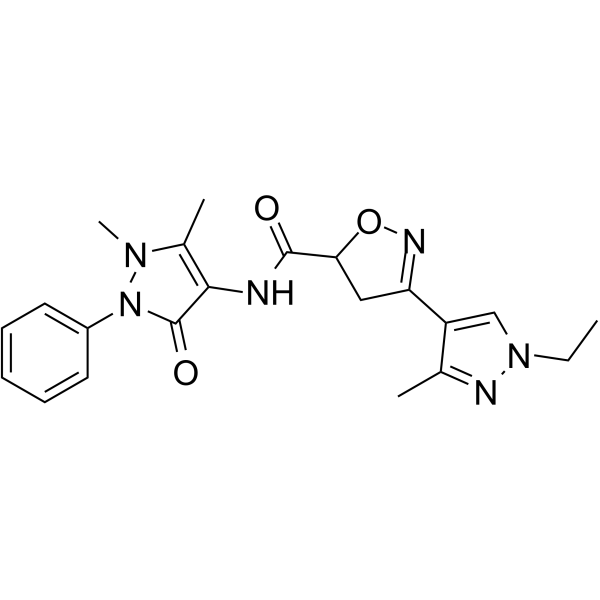Physicochemical Properties
| Molecular Formula | C21H24N6O3 |
| Molecular Weight | 408.45 |
| Exact Mass | 408.19 |
| CAS # | 1006335-39-2 |
| PubChem CID | 17095977 |
| Appearance | White to off-white solid powder |
| Density | 1.4±0.1 g/cm3 |
| Index of Refraction | 1.672 |
| LogP | 0.18 |
| Hydrogen Bond Donor Count | 1 |
| Hydrogen Bond Acceptor Count | 6 |
| Rotatable Bond Count | 5 |
| Heavy Atom Count | 30 |
| Complexity | 760 |
| Defined Atom Stereocenter Count | 0 |
| SMILES | CCN1N=C(C)C(C2=NOC(C(NC3=C(C)N(C)N(C4=CC=CC=C4)C3=O)=O)C2)=C1 |
| InChi Key | YMLINDVVJXDIRW-UHFFFAOYSA-N |
| InChi Code | InChI=1S/C21H24N6O3/c1-5-26-12-16(13(2)23-26)17-11-18(30-24-17)20(28)22-19-14(3)25(4)27(21(19)29)15-9-7-6-8-10-15/h6-10,12,18H,5,11H2,1-4H3,(H,22,28) |
| Chemical Name | N-(1,5-dimethyl-3-oxo-2-phenylpyrazol-4-yl)-3-(1-ethyl-3-methylpyrazol-4-yl)-4,5-dihydro-1,2-oxazole-5-carboxamide |
| HS Tariff Code | 2934.99.9001 |
| Storage |
Powder-20°C 3 years 4°C 2 years In solvent -80°C 6 months -20°C 1 month |
| Shipping Condition | Room temperature (This product is stable at ambient temperature for a few days during ordinary shipping and time spent in Customs) |
Biological Activity
| ln Vitro | Only Dd2 channels (K0.5 values of 56 nM and 43 μM for Dd2 and HB3 channels, respectively) are effectively inhibited by ISPA-28[2]. |
| References |
[1]. Sanjay A Desai, et al. Ion and Nutrient Uptake by Malaria Parasite-Infected Erythrocytes. [2]. Wang Nguitragool, et al. Proteolysis at a Specific Extracellular Residue Implicates Integral Membrane CLAG3 in Malaria Parasite Nutrient Channels. |
Solubility Data
| Solubility (In Vitro) | DMSO : 100 mg/mL (244.83 mM) |
| Solubility (In Vivo) |
Solubility in Formulation 1: ≥ 2.5 mg/mL (6.12 mM) (saturation unknown) in 10% DMSO + 40% PEG300 + 5% Tween80 + 45% Saline (add these co-solvents sequentially from left to right, and one by one), clear solution. For example, if 1 mL of working solution is to be prepared, you can add 100 μL of 25.0 mg/mL clear DMSO stock solution to 400 μL PEG300 and mix evenly; then add 50 μL Tween-80 to the above solution and mix evenly; then add 450 μL normal saline to adjust the volume to 1 mL. Preparation of saline: Dissolve 0.9 g of sodium chloride in 100 mL ddH₂ O to obtain a clear solution. Solubility in Formulation 2: ≥ 2.5 mg/mL (6.12 mM) (saturation unknown) in 10% DMSO + 90% (20% SBE-β-CD in Saline) (add these co-solvents sequentially from left to right, and one by one), clear solution. For example, if 1 mL of working solution is to be prepared, you can add 100 μL of 25.0 mg/mL clear DMSO stock solution to 900 μL of 20% SBE-β-CD physiological saline solution and mix evenly. Preparation of 20% SBE-β-CD in Saline (4°C,1 week): Dissolve 2 g SBE-β-CD in 10 mL saline to obtain a clear solution. Solubility in Formulation 3: ≥ 2.5 mg/mL (6.12 mM) (saturation unknown) in 10% DMSO + 90% Corn Oil (add these co-solvents sequentially from left to right, and one by one), clear solution. For example, if 1 mL of working solution is to be prepared, you can add 100 μL of 25.0 mg/mL clear DMSO stock solution to 900 μL of corn oil and mix evenly. (Please use freshly prepared in vivo formulations for optimal results.) |
| Preparing Stock Solutions | 1 mg | 5 mg | 10 mg | |
| 1 mM | 2.4483 mL | 12.2414 mL | 24.4828 mL | |
| 5 mM | 0.4897 mL | 2.4483 mL | 4.8966 mL | |
| 10 mM | 0.2448 mL | 1.2241 mL | 2.4483 mL |
